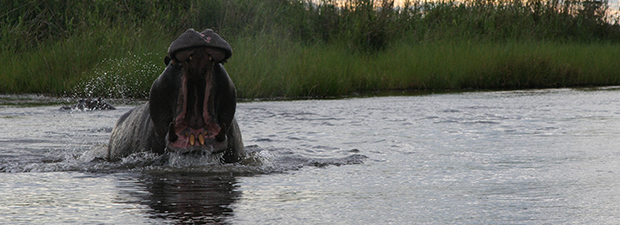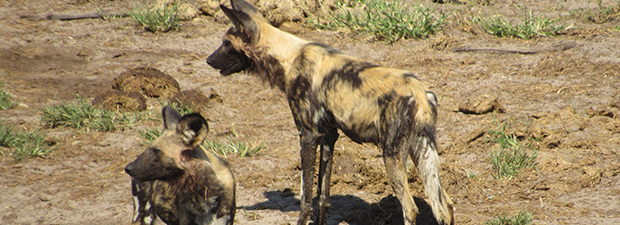Destinations
- Chobe National Park
- Okavango Delta
- Savuti
- Khwai Concession
- Moremi Game Reserve
- Nxai Pan National Park
- Tsodilo Hills
- Central Kalahari Game Reserve
- Makgadikgadi National Park

Chobe National Park
Whether arriving by air or road, the first glimpse of the Chobe River is always breath-taking. It appears as a swathe of bright, blue ribbon, winding its way through the tiny town of Kasane and out into the Chobe National Park's wilderness. One of Africa's most beautiful rivers, the Chobe, supports a diversity and concentration of wildlife unmatched in Botswana.
Established in 1968, Chobe National Park covers approximately 11,700 sq km, encompassing floodplains, swamps and woodland. The Chobe River forms the park's northern boundary, which includes four distinct geographical areas: the Chobe Riverfront: the Ngwezumba pans; Savuté; and Linyanti.
The most accessible and frequently visited of Botswana's big game country, the Chobe Riverfront, is most famous for the large herds of elephants and Cape Buffalo that converge on the riverbank to drink during the dry winter months.
During this season, on an afternoon game drive, you may see hundreds of elephants at one time. The main Serondella Road sometimes becomes impassable as scores of family herds cross the main road to make their way to the river to drink, bathe and play.
Driving the tracks and trails close to the riverbank, you may see as many 15 different species of animals on any one drive. Common species include waterbuck, lechwe, puku (endemic to this area), giraffe, kudu, roan and sable, impala, warthog, bushbuck, monkeys and baboons, along with the accompanying predators such as lion, leopard, hyena and jackal, who are never far away.

Okavango Delta
The Okavango River cuts through the center of the Kalahari Desert, creating a unique inland water system that gives life to a huge variety of birds and animals.
The Okavango Delta is a unique safari destination because you can view much of its wildlife from a traditional canoe, or mokoro. Every year the delta floods cover over 6,175 square miles/ 16,000 square kilometres.
The best time to view wildlife is during peak flood season (which is ironically during the May-October dry season). Wildlife is more concentrated on the delta islands at this time, making it easier to spot.
There are numerous lodges and luxury safari camps, many of which offer walking safaris and/or island camping trips.

Savuti
Found at the heart of the park, Savuti boasts most of the Chobe region species, except for water-loving antelope. It is best known for its large resident populations of predators, particularly lion, cheetah and hyena.
The Savuti channel flows from the Linyanti River for about 100 km, carrying water away from the river, releasing it into a vast swampland called the Savuti Marsh, and further south on to the Mababe Depression, also fed by the Ngwezumba River from the northeast. The Mababe – immense and flat and fringed by thickets of trees – was once part of the Makgadikgadi super-lake. When filled with water, it attracts thousands of migratory birds and animals, vast herds of zebra.
Geographically, Savuti is an area of many curiosities. One of its greatest mysteries is the Savuti channel itself, which has over the past 100 years inexplicably dried up and recommenced its flow several times. Attributed by some to plate tectonics, this irregular water flow results in numerous dead trees lining the channel. These trees germinate and grow when the channel is dry, but they drown when the channel flows again.
At the extreme northern reaches of Botswana, between the Chobe National Park to the east and the Okavango to the south, are the extensive Kwando, Selinda and Linyanti concessions. These properties offer superb wildlife viewing – and terrain to rival the physical beauty of the Okavango.

Khwai Concession
Khwai Concession is a region in the north-eastern Okavango Delta boasting an impressive fauna. It is a superb alternative to the Moremi Game Reserve, which can be visited all year around.The 1800 km² large Khwai Concession is situated right next to the Moremi Game Reserve. Formerly a hunting concession it is today administered by the local community as recreational area. It retrieves its name from the Khwai River, the northern “finger” of the mighty Okavango Delta, which forms the most important source of life in the region. The Khwai Concession is a good example for eco-tourism. All income generated are received by the local community (Khwai Community Trust).

Moremi Game Reserve
In 2008, Moremi Game Reserve was voted 'best game reserve in Africa' by the prestigious African Travel and Tourism Association at South Africa's premier tourism fair, Indaba.
It is the first reserve in Africa to be established by local residents. Concerned about the rapid depletion of wildlife in their ancestral lands – due to uncontrolled hunting and cattle encroachment – the Batawana people of Ngamiland, under the leadership of the deceased Chief Moremi III's wife, Mrs Moremi, took the bold initiative to proclaim Moremi a game reserve in 1963. It is the only officially protected area of the Okavango Delta. As such, it holds tremendous scientific, environmental and conservation importance. To this day, Moremi ranks as one of the most beautiful reserves in Africa, possibly in the world.
Moremi Game Reserve is situated in the central and eastern areas of the Okavango. It includes the Moremi Tongue and Chief's Island, boasting one of the continent's wealthiest and most diverse ecosystems.
This makes for spectacular game viewing and bird watching, including all significant, naturally occurring herbivore and carnivore species in the region and over 400 species of birds, many migratory and some endangered. Both Black and White Rhino have recently been re-introduced, making the reserve a 'Big Five' destination.
Covering approximately 3,900 sq. km, where land and Delta meet, Moremi Game Reserve is a profoundly picturesque preserve of seasonal and perennial floodplains. The landscape includes waterways, lagoons, pools, pans, grasslands, and forests. This terrain makes driving Moremi's many tracks and trails delightful and exceptionally inspiring.

Nxai Pan National Park
The Nxai Pan National Park is a spectacular destination for a safari. The scenery is the main draw here, with wonderful sand dunes, towering baobab trees, and of course the salt pans themselves.
When flooded, the pans also offer tremendous birding and game-viewing opportunities. Short grasses replace the salt pans and attract vast herds of ungulates—including zebra and wildebeest. The best time to visit is from December to April.
The location in northeastern Botswana makes it easy to combine your visit with a trip to Chobe and the Okavango Delta, which reaches into the park. Lodging here is only possible as part of a mobile camp, but nearby Makgadikgadi Pan camps are also an excellent option.

Tsodilo Hills
Tsodilo Hills is a spiritual outdoor art gallery, showcasing more than 4,000 ancient San Bushmen rock paintings. There are around 400 sites depicting hunting scenes, ritual dances and typical safari animals. Some rock art dates back more than 20,000 years and archaeologists have ascertained that people lived in this area as far back as 100,000 years ago.
The San Bushmen believe this sacred area is the site of the first creation of man and a resting place for spirits of the dead. Not surprisingly, this is a UNESCO World Heritage Site.
Visitors can expect to hike the three main hills, with the assistance of local guides. There is a basic campsite and a small but informative museum on site.

Central Kalahari Game Reserve
CKGR is within the Ghanzi District, and together with Khutse Game Reserve they form the largest Game Reserve complex in Botswana and the third largest Game Reserve in the world. Forming part of the Kalahari eco system, it supports a wide variety of animals such as Wildebeest ,Hartebeest, Eland, Springbok ,Kudu ,Giraffe ,Brown Hyena, Warthog, Cheetah, Wild Dog, Leopard ,Lion ,Blue Wildebeest and Gemsbok.The word “Kalahari” is derived from the Tswana word “Kgala” meaning “great thirst “–and it has vast areas without any permanent water. The term “desert” is however not quite accurate when referring to the Kalahari, the region receives an annual rainfall of 60 mm – 175 mm,too high to be classified as a true desert.
The Kalahari’s vegetation consists mainly of grasses and acacia’s as well as stunted thorn and scrub bush. There are over 400 identified plant species present. Annual rain season is between December and March when summer temperatures can get quite high. After the summer rains – the CKGR completely transforms as the blue sky fills with huge clouds, and the plains and pans burst with sweet grasses.
This is one of the best game viewing areas in Botswana at this time of the year and not many people seem to be aware of this – so the visitors are few. The dry season between May – September is also a wonderful time to visit the CKGR s the animals congregate close to any surface water and pans.CKGR activities are considered as “Dry Safari” ,while the Okavango is referred to as “Wet Safari” – terms synonymous with the conditions found in the two areas subsequently.

Makgadikgadi National Park
Imagine – if you will – an area the size of Portugal, largely uninhabited by humans. Its stark, flat, featureless terrain stretches – it would seem – to eternity, meeting and fusing with a milky-blue horizon. This is the Makgadikgadi – an area of 12 000 sq kms, part of the Kalahari Basin, yet unique to it – one of the largest salt pans in the world.
For much of the year, most of this desolate area remains waterless and extremely arid; and large mammals are thus absent. But during and following years of good rain, the two largest pans – Sowa to the east and Ntwetwe to the west – flood, attracting wildlife – zebra and wildebeest on the grassy plains – and most spectacularly
flamingos at Sowa and Nata Sanctuary. Flamingo numbers can run into the tens – and sometimes – hundreds of thousands, and the spectacle can be completely overwhelming.
The rainwater that pours down on the pans is supplemented by seasonal river flows – the Nata, Tutume, Semowane and Mosetse Rivers in the east, and in years of exceptional rains, the Okavango via the Boteti River in the west.
About Us
We are a Mobile Tour Operator offering mobile safaris, boat cruises, mokoro excursions, quad biking and tourist transfers... Read More
Address
PO Box 21754, Maun Botswana
Plot 25907, Moeti Ward
Maun, Botswana
Call Us
+267 77 001 535
+267 72 850 708
Email Us
info@bushlullabies.com
bookings@bushlullabies.com
